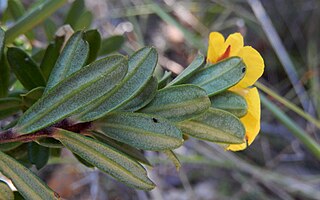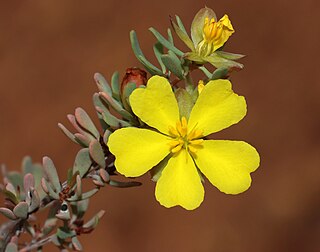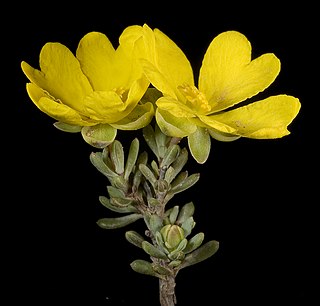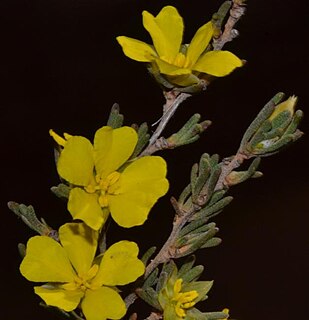
Hibbertia acerosa, commonly known as needle leaved guinea flower, is a species of flowering plant in the family Dilleniaceae and is endemic to the south-west of Western Australia. It is a low, spreading or ascending shrub typically growing to a height of 10–60 cm (3.9–23.6 in) and has yellow flowers from July to December or from January to February.

Hibbertia bracteata is a species of flowering plant, in the family Dilleniaceae, and is endemic to eastern New South Wales. It is a shrub with lance-shaped to oblong leaves and yellow flowers with about sixteen stamens arranged on one side of the two carpels.
Hibbertia banksii is a species of flowering plant in the family Dilleniaceae and is native to Queensland and New Guinea. It is a shrub with thick, leathery leaves and yellow flowers with about twenty to forty-eight stamens arranged on one side of the two carpels.
Hibbertia dealbata is a species of flowering plant in the family Dilleniaceae and is endemic to northern Australia. It is an erect shrub that typically grows to a height of up to 2 m. It is similar to Hibbertia brownii but has lance-shaped to egg-shaped leaves with the lower end towards the base and flattened hairs on the lower surface. The flowers are arranged on the ends of the branchlets.

Hibbertia desmophylla is a species of flowering plant in the family Dilleniaceae and is endemic to the south-west of Western Australia. It is a sprawling or erect, hairy shrub with spreading, densely clustered, linear leaves and yellow flowers with eleven to thirteen stamens.

Hibbertia dilatata is a species of flowering plant in the family Dilleniaceae and is endemic to the Northern Territory. It is a sub-shrub with flattened stems and pale to bright pink, purplish or white flowers with seven to ten stamens.
Hibbertia echiifolia is a species of flowering plant in the family Dilleniaceae and is endemic to northern Australia. It is a variable shrub with elliptic to lance-shaped or oblong leaves and yellow flowers arranged singly in leaf axils, with twenty-nine to forty-five stamens arranged around the three carpels.
Hibbertia furfuracea is a species of flowering plant in the family Dilleniaceae and is endemic to near-coastal areas of south-western Western Australia. It is an erect shrub with narrow egg-shaped leaves with the narrower end towards the base, and yellow flowers borne in upper leaf axils, with ten to twelve stamens all on one side of two carpels.

Hibbertia glomerata is a species of flowering plant in the family Dilleniaceae and is endemic to the south-west of Western Australia. It is a much-branched shrub with mostly oblong or egg-shaped to elliptic leaves and yellow flowers borne on the ends of short side shoots, with nine to twelve stamens, sometimes in groups of three, arranged around the three carpels.

Hibbertia glomerosa is a species of flowering plant in the family Dilleniaceae and is endemic to the south-west of Western Australia. It is a shrub with linear to narrow oblong leaves and bright yellow flowers borne on the ends of short side shoots, with twenty-five to thirty-eight stamens arranged in groups of five around the five glabrous carpels.

Hibbertia gracilipes is a species of flowering plant in the family Dilleniaceae and is endemic to the south-west of Western Australia. It is an erect, multi-stemmed shrub that typically grows to a height of 15–60 cm (5.9–23.6 in). It blooms between March and December producing yellow flowers. First formally described in 1863 by George Bentham in Flora Australiensis, the specific epithet (gracilipes) means "thin foot", referring to the peduncles.
Hibbertia hirsuta is a species of flowering plant in the family Dilleniaceae and is endemic to southern Australia. It is a small, slender, prostrate shrub with sparsely hairy foliage, narrow elliptic leaves and small yellow flowers with a single petal, usually only a single stamen and two carpels.

Hibbertia inclusa is a species of flowering plant in the family Dilleniaceae and is endemic to the south-west of Western Australia. It is an erect, spreading shrub that typically grows to a height of 20–90 cm (7.9–35.4 in). It was first formally described in 1863 by George Bentham in Flora Australiensis from specimens collected from the Swan River Colony by James Drummond. The specific epithet (inclusa) means "enclosed", referring to the flowers being enclosed in floral bracts.
Hibbertia juncea is a species of flowering plant in the family Dilleniaceae and is endemic to the Northern Territory. It is a small shrub with leaves reduced to minute scales, and white to cream-coloured or pink flowers arranged in leaf axils with seven to ten stamens.

Hibbertia lasiopus is a species of flowering plant in the family Dilleniaceae and is endemic to the south-west of Western Australia. It is prostrate, ascending sometimes erect shrub that typically grows to a height of 10–50 cm (3.9–19.7 in). It was first formally described in 1863 by George Bentham in Flora Australiensis from specimens collected from the Swan River Colony by James Drummond. The specific epithet (lasiopus) means "shaggy foot", referring to the flowers' hairy peduncles.
Hibbertia ledifolia is a species of flowering plant in the family Dilleniaceae and is endemic to the Kimberley region of Western Australia. It is an erect shrub that typically grows to a height of 1–2 m and has yellow flowers from April to June. It was first formally described in 1863 by George Bentham in Flora Australiensis from specimens collected from York Sound by Allan Cunningham. The specific epithet (ledifolia) means "Ledum-leaved", referring to the broom-like shape of the shrub.

Hibbertia leptopus is a species of flowering plant in the family Dilleniaceae and is endemic to Western Australia. It is an erect shrub with linear leaves and yellow flowers, usually with eleven stamens arranged around the three carpels.

Hibbertia mucronata is a species of flowering plant in the family Dilleniaceae and is endemic to the south of Western Australia. It is an erect shrub with hairy branches, crowded, thick, tapering linear leaves ending in a sharp point, and golden yellow flowers with five stamens fused at their bases, all on one side of two densely hairy carpels.
Hibbertia nitida is a species of flowering plant in the family Dilleniaceae and is endemic to the Central Coast of New South Wales. It is an erect shrub with lance-shaped leaves with the narrower end towards the base and yellow flowers with about eleven stamens arranged on one side of two silky-hairy carpels.
Hibbertia nutans, commonly known as nodding guinea flower, is a species of flowering plant in the family Dilleniaceae and is endemic to the south-west of Western Australia. It is an erect shrub that typically grows to a height of 0.2–1.0 m and flowers between August and October producing yellow flowers. It was first formally described in 1863 by George Bentham in Flora Australiensis from specimens collected in 1843 by James Drummond in the Swan River Colony. The specific epithet (nutans) means "nodding".










